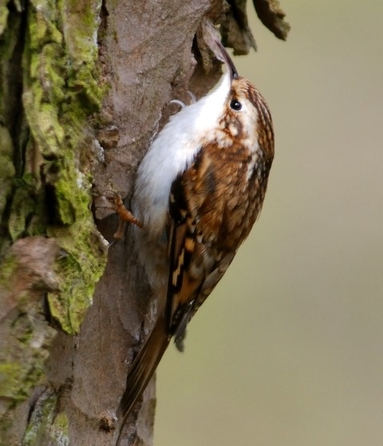Treecreeper

The Treecreeper is one of the more specialised of our relatively common birds. As the name suggests, it creeps on trees. Similar in size to a Wren, it appears larger because of its longer down-curved bill and its much longer stiff tail. Often described as being ‘mouse-like’ the Treecreeper is essentially brown above, with a long white stripe above the eye and mottled white markings on the wings and back, and white below. The intricately patterned brown plumage is ideal camouflage for a bird working its way up a tree trunk, always up never down, foraging up one tree, working in a spiral around the trunk, seeking out small insects and other invertebrates, then flying to the next tree, starting near the bottom and repeating the process.
The Treecreepers are a family, Certhiidae, of small passerine birds, widespread in wooded regions of the Northern Hemisphere and sub-Saharan Africa. The family contains ten species. Here in Scotland at the end of the 18th century Treecreeper was found only in the south. Aforestation, however, may have helped its spread in the 19th century. Now its distribution in general matches that of deciduous and mixed woodland in Scotland. It also occurs in coniferous woodland particularly Scots Pine, but is uncommon in large spruce plantations. Data from the national atlas suggests that numbers have been broadly stable over the last thirty years. The sedentary nature of Treecreeper in Scotland is demonstrated by the fact that only four of the twelve Scottish recoveries of ringed birds moved more than ten kilometres.
Here on Arran, Robert Gray, Birds of Arran, Bell, 1872 describes it "as common in suitable places". The information collected for our local atlas suggests that it is a common resident breeding bird with a stable distribution. Yet because of its skulking habits it is easily overlooked. Winter, before the leaves return to the trees, is a good time to look out for this small, very active bird foraging up tree trunks. In autumn and winter, it often joins flocks of tits and other small birds, so if you come across such a flock in a wood, it is worth checking it out for Treecreeper. Treecreepers will visit those gardens with suitable mature trees and can be tempted to take fat, smeared onto the trunk, during poor winter weather. They are vulnerable to cold weather of a particular sort. If wet snow or rain is followed by a hard frost, ice encases the trees. The Trecreepers’ food is sealed in and the birds are in trouble. These conditions rarely affect the sheltered interiors of woods and so Treecreepers in good habitat may be less likely to suffer than some other small species. However, those that rely on a network of more exposed trees, perhaps those that typically visit gardens, can be vulnerable. In winter they do need to be able to feed through all available daylight.
Nesting is generally at the same time as the tits, as the breeding adults need to take advantage of the same glut of caterpillars at the beginning of June. There are very few second broods. The nest site is generally rather constricted, often squeezed behind a hanging piece of bark. Usually a bed of tiny twigs lines the nest cavity and it generally has two openings, one used as the entrance and the other as the exit. Similar nest like spaces are used as roosting spaces in the winter. In addition, trees with soft fibrous bark like Coast Redwoods and Wellingtonias are used. These trees are doubtless favoured due to the ease of excavation and the insulating quality of the bark. Most roost hollows are found about eight feet from the ground and below the lowest branches.